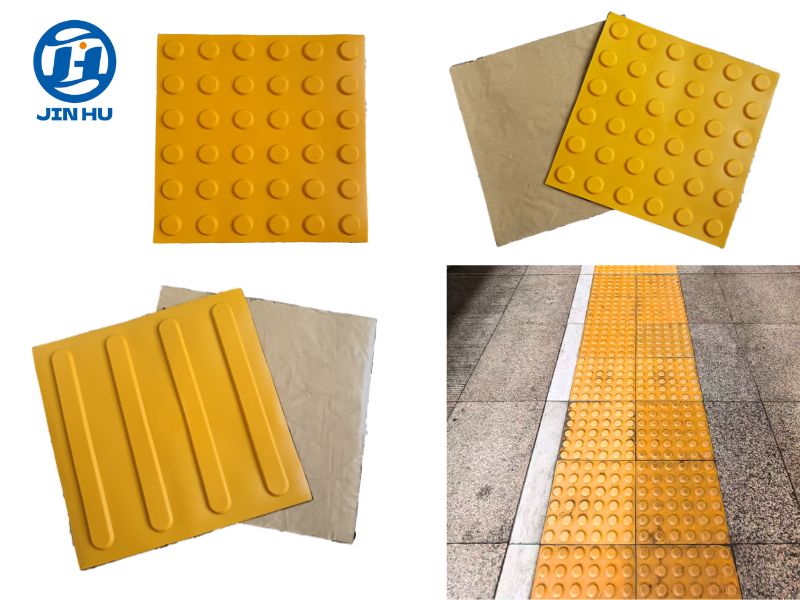What Are You Looking For?
In the pursuit of creating more inclusive urban environments,the development and application of braille pathway tiles have become increasingly significant.These tiles are specifically designed to assist visually impaired individuals in navigating public spaces safely and independently.Among the various materials available for manufacturing these tiles,PVC,TPE,and ABS have emerged as popular choices due to their unique properties and adaptability.

Material Choices:PVC,TPE,and ABS
PVC(Polyvinyl Chloride)
PVC is a widely used material known for its durability and versatility.It is a hard,rigid plastic that can be modified to achieve different levels of flexibility.The key advantages of using PVC for braille pathway tiles include:
• Durability:PVC tiles are resistant to wear and tear,making them suitable for high-traffic areas.
• Chemical Resistance:They can withstand exposure to various chemicals,ensuring long-term performance.
• Cost-Effective:PVC is relatively inexpensive,making it an economical choice for large-scale installations.
• Customizability:PVC can be easily molded into different shapes and sizes,allowing for the creation of tiles that meet specific design requirements.
However,PVC has some drawbacks,such as its potential to release harmful chemicals when burned and its lower environmental sustainability compared to other materials.
TPE(Thermoplastic Elastomer)
TPE is a flexible material that combines the properties of rubber with the processing advantages of thermoplastics.Its features include:
• Flexibility and Elasticity:TPE tiles can bend and flex without breaking,providing a comfortable surface for walking.
• Softness:The material can be adjusted to different levels of softness,making it suitable for areas where a gentle touch is required.
• Recyclability:TPE is more environmentally friendly as it can be recycled and reused.
• Weather Resistance:TPE tiles can withstand harsh weather conditions,maintaining their performance over time.
TPE is an excellent choice for applications where flexibility and softness are crucial,such as in parks or pedestrian walkways.
ABS(Acrylonitrile Butadiene Styrene)
ABS is a strong,impact-resistant plastic known for its toughness and durability.Its benefits for braille pathway tiles include:
• High Impact Resistance:ABS tiles can withstand heavy impacts without cracking or breaking,making them ideal for busy streets and public areas.
• Dimensional Stability:The material maintains its shape and size under various environmental conditions.
• Ease of Processing:ABS can be easily molded and shaped,allowing for the production of tiles with precise braille patterns.
• Aesthetic Appeal:ABS tiles can be produced in a wide range of colors,enhancing the visual appeal of public spaces.
ABS is a versatile material that offers a balance of strength and durability,making it suitable for a variety of applications.
Adhesive-Backed Tiles for Easy Installation
One of the significant advancements in braille pathway technology is the development of adhesive-backed tiles.These tiles come with a self-adhesive backing that simplifies the installation process.The benefits of adhesive-backed tiles include:
• Ease of Installation:The self-adhesive backing allows for quick and easy installation,reducing the time and labor required.
• Versatility:These tiles can be applied to various surfaces,including concrete,asphalt,and existing tiles,making them suitable for retrofitting projects.
• Durability:Once installed,the adhesive provides a strong bond,ensuring that the tiles remain in place even in high-traffic areas.
• Maintenance:Adhesive-backed tiles are easy to clean and maintain,ensuring that the braille patterns remain clear and visible.
The ability to adjust the softness and hardness of the tiles further enhances their usability.For example,softer tiles can be used in areas where comfort is a priority,while harder tiles can be installed in high-traffic zones where durability is essential.
Applications and Impact
Braille pathway tiles made from PVC,TPE,and ABS are used in a variety of settings,including:
• Sidewalks and Pedestrian Walkways:Providing safe navigation routes for visually impaired individuals.
• Public Buildings:Enhancing accessibility in government buildings,schools,and hospitals.
• Transportation Hubs:Assisting visually impaired travelers in navigating train stations,bus stops,and airports.
• Parks and Recreational Areas:Ensuring that visually impaired individuals can enjoy outdoor spaces safely.
The use of these tiles not only improves the accessibility of public spaces but also promotes a more inclusive society.By providing visually impaired individuals with the means to navigate independently,these tiles contribute to their overall quality of life.
The development of braille pathway tiles made from PVC,TPE,and ABS represents a significant step forward in creating more accessible urban environments.These materials offer a range of benefits,from durability and chemical resistance to flexibility and softness.The addition of adhesive backing and the ability to adjust softness and hardness further enhance their usability and adaptability.As cities around the world strive to become more inclusive,the adoption of these tiles will play a crucial role in ensuring that public spaces are accessible to all.
If you need anything, please contact us,Customized different size/color/shape rubber/pvc products, making molds depending on your samples or drawings. FREE SAMPLES can be sent for your evaluation!
Over 20 years Professional Experience in Auto Accessories Field